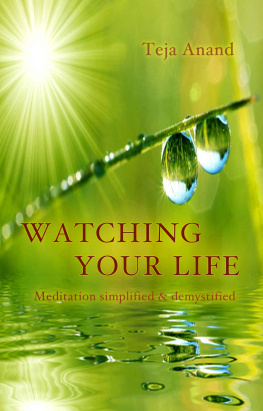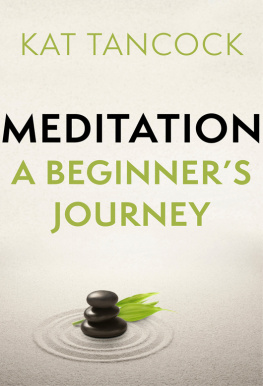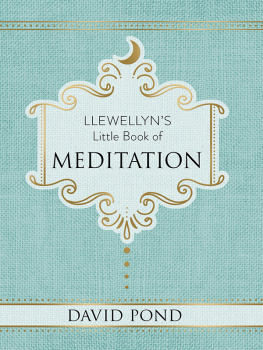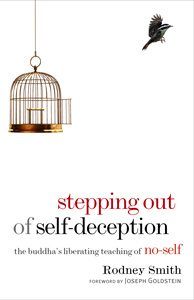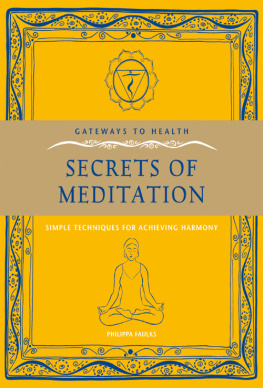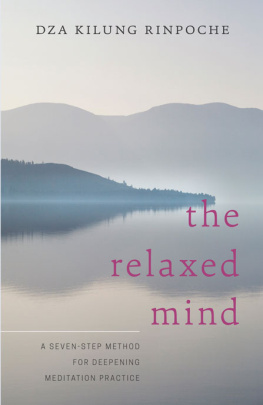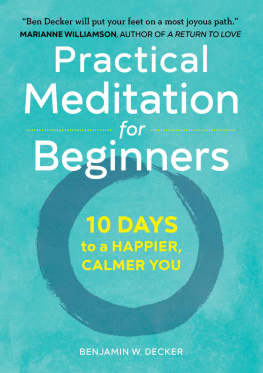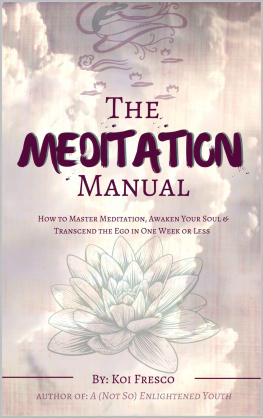WATCHING YOUR LIFE
Meditation simplified & demystified
WATCHING YOUR LIFE
Meditation simplified & demystified
Teja Anand
Copyright 2019
All rights reserved
Anatta Press

CONTENTS:
PART 1: MEDITATION SIMPLIFIED & DEMYSTIFIED
Introduction: Meditation is Simple.5
1. A brief bit of background
2. What is meditation
3. Now & the flow of life
4. Shifting identification & shifting to other, non-mind, forms of knowing
5. The types of meditation
6. The practice of witnessing (sakshi) & awareness/allowing (visaati)
7. Allowing and letting go of control
8. When, where and how often to practice sakshi vasati meditation
9. Being in the meditative state full-time
10. Feelings and experiences that may come up in meditation
11. The ego-minds argument with reality and resistance to meditation
PART 2: WATCHING YOUR LIFE
1. Conditioned identification38
2. Deeper levels of meditation: samadhi and watching wordlessly
3. Enlightenment: a new easy, explanation
4. Psychological assessment causes unpresence and unneeded suffering
5. Is that actually enlightenment?
6. Living your life, watching your life
PART 3: COMMON QUESTIONS ABOUT MEDITATION
.65.
PART 4: THE SIMPLICITY OF MEDITATION, WITNESSING AND LIFE ITSELF
.107.
WATCHING YOUR LIFE
PART 1: MEDITATION SIMPLIFIED & DEMYSTIFIED
INTRODUCTION: MEDITATION IS SIMPLE
Dear Reader,
Meditation is the simplest thing in the world. Like falling off a log simple. No kidding!
Yet you may have heard some things that made you think its complicated and esoteric.
Have you heard that there are many different types and techniques of meditation?
Probably.
Have there been many learned explanations and treatises on meditation, how it works and what happens in the brain/body/mind during meditation, by centuries worth of wise sages and teachers?
Yes.
Has meditation become so trendy, here in the 21 st century, that you can now find a meditation center or teacher in virtually every neighborhood, each with their own particular method or variation on how to meditate?
You bet.
Has all of this served to confuse you, the beginning meditator . It certainly can. As you will see in the question and answer format in the second part of this book, people come up with all nature of queries about what meditation is, how concerned they are about doing it properly or wrong, or about missing out on the best, ultimate meditation method, and about what results should be expected, all of which can turn meditation into this daunting or mystical endeavor more complicated than it need be.
Thats too bad, because meditation really is a no-brainer (pun intended.) If more people realized that, fewer would be bewildered, or frightened off by something they think they could never be good at, or have time for, and more would enjoy the benefits.
Thats what this book is all about. Demystifying and deconstructing all the confusion around meditation, and confirming that you can begin meditating right now , and experiencing the benefits right now, today.
And what natural, wonderful benefits they are! It can literally transform your life.
1. A BRIEF BIT OF BACKGROUND
Meditation has a long history, going back thousands of years across many cultures and contributors. As far back as 5000 years ago, ascetics who were seeking answers to the essence of existence and the deepest questions of life perfected different forms of deep contemplation, removing themselves first from the distractions of the outer world, and then plummeting through the inner layers of mind and awareness, hopefully to arrive at essential truth and the essential Self.
The best known of these inner voyagers was Buddha, who predated Christ by six centuries. But there are both older & newer masters of meditation and awakening, with a list that must include the ancient teachings of the Hindu Vedas (which contain Krishnas clear instructions in the Bhagavad Gita,) the Yoga Sutras of Patanljali, The Tao Te Ching of Lao Tze, the Advaita teachings of Adi Shankara, and so many more.
For the purposes of this short instruction booklet, devoted to simplifying and demystifying meditation for all, a deep dive into meditations history is not necessary or useful; it will only confuse and fill our minds with excess information. Those with a historical bent who want to do a deeper exploration of meditations past-to-present development will find ample information throughout the Internet.
Similarly, because this book will focus on showing you the simplest, most direct form of meditation, Witnessing & Allowing, we wont be delving deep into the many other recognized forms & techniques. The author has tried, and taught, them all, and can clearly affirm the Witnessing-Allowing-Awareness (SakshiVasati) meditation presented in these pages is the most simple, direct and impactful form of meditation for both beginners and advanced meditators.
All meditation techniques can essentially be divided into two categories: methods based on focusing the mind on an object of concentration (such as the breath, a mantra, a visual object like a candle flame, or a full up-&-down scan of the body) and methods of simply observing all phenomena without focus, being directly with the Observer than the observed.
If you have researched meditation a bit, you probably have encountered there are many subsets of these two basic categories. More detail about other meditation forms is mentioned further on in the book.
In Watching Your Life, it is the authors desire to get you meditating and directly experiencing the benefits as quickly as possible, so we will proceed directly to exposition and instruction of the SakshiVasati Witnessing-Allowing-Awareness approach. Clogging the mind with a lot of alternate approaches just brings us back to confusion and worry of missing out on the best method. Learn this simple Witnessing-Allowing-Awareness method first and practice it with regularity for a while. It is doubtful, after that practice, that you will have much concern or curiosity about the numerous other approaches, but if you do, you can always circle back around to them at a later date, now firmly established in the most direct path.
2. WHAT IS MEDITATION
Meditation is simply releasing the identification
with the mind. Thats it! Mind, here, includes all thoughts, feelings, judgments, emotions, moods and body sensations. This essential definition of meditation will be repeated often throughout this book, to help you remember both the simple purpose and practice of meditation.
Most of the time, we identify with our minds, our thoughts, emotions and body sensations. Commonly and erroneously, we dont just think we have these, we think we are these. We hear the running narrative in our head that chatters Im anxious, Im angry, Im unsatisfied or I want something, I must get something, plan something, do something and, instead of just noticing, just being aware of these feelings, we think we are that, we think we, our entire being, is really worried, upset or unsatisfied. That same voice ruminates over the past and future, over plans, health & money concerns, desires and judgments of ourselves or others, and once again, we dont feel we have this ruminating mind and running internal voice, we think and operate as if we are that voice. We identify with it.
This is how most of us live our entire lives.
In reality, we are not our thoughts, emotions and body sensations, nor are we the sum total of them. We have those, so we couldnt be those. Then who has them? We are the silent, neutral watcher who is simply observing all that, while Itself is remaining totally still, non-judgmental and unfazed. We are Awareness, the Space in which all that appears. We can experience this directly.
Next page
